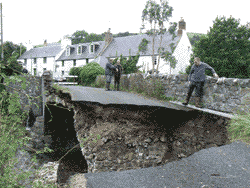Floods leave Scottish farmers stranded

|
|---|
Tom Macfarlane, who runs 4000 ewes at Flass, Lauder, lost 370 Suffolk cross lambs on the River Till just over the Border at Ewart, Wooler. “We had a third of our annual rainfall in 36 hours,” he said.
“The river is usually 3ft deep and 20ft wide, but on Sunday it was 20ft deep and a mile wide. Our sheep were swept away and our neighbour also lost about 300 head. Some cattle were also lost, but they seem to be better swimmers than sheep.”
At Clifton on Bowmont, Kelso, a bridge was swept away, leaving James Playfair-Hannay with no access to 40ha (100 acres) of crops ready for combining and 1000 sheep due to be sold at a dispersal sale.
Neighbouring farmer Alan Goodson, vice-chairman of NFU Scotland‘s combineable crops committee, said remaining cereals crops were deteriorating by the day and sprouting was becoming a problem.
 |
|---|
| James Playfair-Hannay found himself cut off from his crops and livestock after this bridge was swept away at Clifton on Bowmont, Kelso. |
“There is a massive amount of straw still to bale and straw could be a real problem for livestock farmers this winter,” he said. “Very little oilseed rape has been sown with harvest being so late.”
NFU Scotland president Jim McLaren, who toured the flood-hit area on Tuesday, said: “The majority of Scottish farmers have only brought in half of their harvest and much of it is poor quality because it has been so wet.”
Many fields of potatoes were under water, said Mr McLaren, representing a loss of £5500/acre. Fields of cereals and vegetables had also been destroyed.
Bruce Ferguson, regional general manager for Grainfarmers, said about 90% of the spring barley crop had been secured in central Scotland and the Borders. Quality had proved variable, with high levels of pre-germination.
Only half of the winter wheat crop had been harvested and combining was proving extremely difficult, with high moisture levels. Conditions were much better further north, where some barley crops were not yet ready because of late sowing in the spring.
| WORST HARVEST WEATHER EVER? Show other FW readers the real picture in your region.
|
|---|

